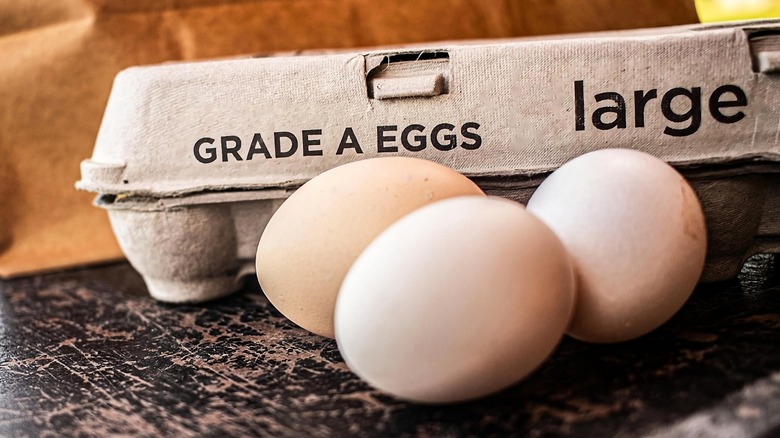Here's Why Eggs Have Grades And What They Actually Mean
When you're making a grocery run and need to pick up a carton of eggs for that perfect fried egg you eat every morning or your weekend baking project, you're faced with several choices. Do you take a dozen or a pack of 18? Should you go with cage-free or free-range eggs? Brown or white? Then there's that USDA label: the egg grade. But is there really a difference between a grade A egg and a grade AA? The short answer is yes, but for the average consumer, it's not a particularly noticeable one.
The United States Department of Agriculture (USDA) gives grades to eggs as a service that egg producers voluntarily submit to and pay for in an effort to inform shoppers. As an objective third party, the USDA awards eggs one of three grades — AA, A, and B — based on the appearance and condition of the shells as well as the quality of their interior.
How the USDA determines an egg's grade
The egg-grading process is performed by people called egg graders, who are trained to make rapid assessments of each egg. Egg grading involves grouping eggs with similar traits (quality, weight, and color) together. Quality is based on the conditions of the whites and yolks as well as how sound and clean the shell is. Graders are looking for smooth, well-shaped, undented shells, consistently thick and firm whites, and high, round yolks to award their best grades.
The quality is determined through visual inspection as well as with a method called candling, which involves shining a strong light into an egg to see inside it. Poultry farmers often do this when eggs are in incubators, to see developing embryos; although the eggs you purchase at the store are unfertilized, candling helps with the egg-grading process. Though you can't see fine details, it reveals cracks in the shell, blood spots, or other problems with the white or yolk inside.
What each grade signifies
You're likely to see three egg grades as you do your shopping. Grade AA eggs are clean and unbroken with clear, firm whites and yolks that are free from defects and clearly outlined, as determined by inspection. Eggs graded AA are the freshest, best quality available. Meanwhile, eggs labeled grade A also have clean, unbroken shells, and their whites are also clear and reasonably firm, with yolks that are fairly well-defined and free from defects. Though not quite to the exceptionally high standards of grade AA, eggs bearing the grade A also are very high in quality. Either option is good enough to eat on its own, and it would be difficult for the average consumer to notice a difference.
The final grade is a B. You won't usually find a grade B egg in the dairy aisle, as this grade is awarded to eggs with shells that are unbroken but perhaps abnormally shaped or stained. Their whites may be weak and watery, perhaps with blood spots, and the yolks may be defective in shape or size. These eggs are usually found in cartons (liquid eggs) or in baked goods. In short, the egg grades you will encounter in grocery stores are all considered high quality, which should put your mind at ease in terms of making that selection when you're shopping.


